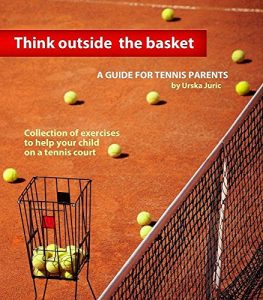This book is dedicated to tennis parents who want to help their children on the tennis court. It is for every tennis parent; even the ones who do not know how to hold a racket in their hands but are huge fans of tennis and have a great understanding of the game, as well as the tennis parents who are recreational tennis players, tennis coaches, or parents who used to be competitive tennis players and are looking for some fun, creative, and helpful exercises on the tennis court.
This book may also be suitable for tennis coaches who are injured and are not allowed to hit tennis balls or move much on the court. Therefore, this book is for everyone who wants to spend some quality time on the tennis court with their children or students and help them grow. The book is also equipped with visuals for easy understanding of each exercise.
Urska Juric just recently published her first book, 24 Tennis Lessons, which is dedicated to coaches and consists of twenty-four one-hour-long fun and creative tennis lessons, including 111 exercises, with lessons divided into groups according to a child’s age, ranging from five years and up.
This book, Think Outside the Basket, is primarily dedicated to tennis parents. As Urska slowly cruised through her twenty-six years of tennis experience as a competitive tennis player and later as a coach, she noticed a few things that are true for almost every tennis parent. Tennis parents are very caring and passionate about their children’s success on the tennis court. They really want their children to succeed and be happy and healthy individuals; however, many times, Urska noticed parents are the ones who don’t get enough guidance and support with how to help their children on their tennis journey. She often encountered parents who really wanted to be involved in tennis practice, sometimes to the point where it hindered the coach’s plan and authority on the court. Many coaches get frustrated, and in order to continue their practices, had to set strict bounders with parents, making the parents feel excluded, which in turn affects the overall coach-parent-child relationship. In other cases, coaches stopped working with children whose parents were hindering the lessons and progress due to over involvement during the lessons. There are many other cases without plausible solutions for the coach-parent relationship, and in the end, the child is the one who loses the most. This is why Urska wrote this book; because she wanted parents who feel the need to get involved to do it on a more helpful level. Therefore, this book is a collection of exercises a parent and child can do on the tennis court by themselves. All that is needed is a basket of tennis balls and a solid toss, which can be easily mastered. Children will be happy their parents are spending time with them, and at the same time, parents will feel useful and helpful. For some parents, this approach may decrease their tennis expenses or can be used when the coach is not available.
This book may also be suitable for tennis coaches who are injured and are not allowed to hit tennis balls or move much on the court. Therefore, this book is for everyone who wants to spend some quality time on the tennis court with their children or students and help them grow. The book is also equipped with visuals for easy understanding of each exercise.
Urska Juric just recently published her first book, 24 Tennis Lessons, which is dedicated to coaches and consists of twenty-four one-hour-long fun and creative tennis lessons, including 111 exercises, with lessons divided into groups according to a child’s age, ranging from five years and up.
This book, Think Outside the Basket, is primarily dedicated to tennis parents. As Urska slowly cruised through her twenty-six years of tennis experience as a competitive tennis player and later as a coach, she noticed a few things that are true for almost every tennis parent. Tennis parents are very caring and passionate about their children’s success on the tennis court. They really want their children to succeed and be happy and healthy individuals; however, many times, Urska noticed parents are the ones who don’t get enough guidance and support with how to help their children on their tennis journey. She often encountered parents who really wanted to be involved in tennis practice, sometimes to the point where it hindered the coach’s plan and authority on the court. Many coaches get frustrated, and in order to continue their practices, had to set strict bounders with parents, making the parents feel excluded, which in turn affects the overall coach-parent-child relationship. In other cases, coaches stopped working with children whose parents were hindering the lessons and progress due to over involvement during the lessons. There are many other cases without plausible solutions for the coach-parent relationship, and in the end, the child is the one who loses the most. This is why Urska wrote this book; because she wanted parents who feel the need to get involved to do it on a more helpful level. Therefore, this book is a collection of exercises a parent and child can do on the tennis court by themselves. All that is needed is a basket of tennis balls and a solid toss, which can be easily mastered. Children will be happy their parents are spending time with them, and at the same time, parents will feel useful and helpful. For some parents, this approach may decrease their tennis expenses or can be used when the coach is not available.



